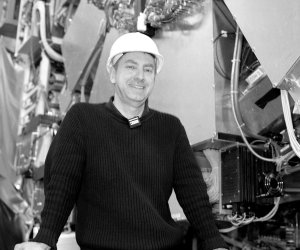 |
|
Commuter Special by Mike Perricone
“I don’t have any spare time,” he said with a chuckle. “But I do try to run every day. Fermilab is a good place to run.”
Lockyer, who officially succeeds cospokesperson Franco Bedeschi at CDF on June 1, is well-acquainted with the pace of the lab. He arrived in 1984, following up his postdoc term on the Mark II experiment at Stanford Linear Accelerator Center by moving on to the faculty of the University of Pennsylvania. He’s been teaching for nearly 20 years at Penn, primarily undergraduate physics courses, while maintaining the frequent-flier routine of the Fermilab visiting scientist. For the last two years, he has stepped up that pace as CDF’s co-chief of operations, with Fermilab physicist Jeff Spalding, and he has usually spent Tuesdays through Fridays at Fermilab.
“The commute from Philadelphia isn’t all that bad,” he said. “In principle, as a cospokesperson you move here. Starting June 1, people should be able to find me when they need me.”
Lockyer and his family live in Wayne, Pennsylvania. Ellen, his wife, teaches nursery school. Geoffrey, the oldest offspring, is at Ohio State; Martin is in high school, and Sara in middle school. Along with a wry sense of humor, always helpful to a cospokesperson for a group of nearly 600 scientists from 58 independent institutions, Lockyer brings an appreciation for the kind of work it takes to keep the 5,000-ton detector operating.
“My primary responsibility for many years was the alarm system,” he said. “The control system checks that voltages are within tolerances, monitors high voltages, turns the high voltage on and off at the beginning of a run. There was formerly a talking computer issuing the alarms, and one of the few benefits of being on shift was programming it to say other, less-pertinent things. It’s probably the most un-glorious job you can have at CDF. I tried to get out of it every year but failed. It’s a thankless job, but it has to be done. So I completely sympathize with people who do that kind of work.”
Lockyer also knows that, despite the lack of acclaim, those tasks are the critical foundation of success.
“The reward system in the field is primarily geared toward people doing physics analysis,” Lockyer continued. “For a postdoc to get a faculty position, that’s determined largely by what physics he or she has done on the experiment. But at least as much work, if not more, is involved in their contribution to building the experiment. In general, and unfortunately, that’s not viewed in same light as the physics results. I’d like to help raise the awareness of how critical that work is, when an experiment is to run for the better part of a decade.”
Lockyer acknowledged the difficulties in both outlook and logistics, but also outlined a possible strategy.
“I want to encourage the university groups to work on even more operational issues in commuter mode,” he said. “They would make their own contributions back at the university, then come in here for couple of days every two weeks and take on an important operational role while they’re here. That will make us a very strong experiment if we can accomplish it.”
Behind Lockyer’s easygoing manner is a firm understanding of what’s at stake well beyond the prestige of a possible discovery in Run II.
“When all is said and done, it will be disappointing if don’t find something,” he said. “We expect to find something—and we’re expected to find something. The high-energy frontier is here and now. The field of high-energy physics, both in this country and internationally, will be influenced by the success of CDF and DZero. That ratchets up the importance of everything we’re doing.”
|
 Soon to become cospokesperson at CDF, Nigel Lockyer already practices life on the run.
Soon to become cospokesperson at CDF, Nigel Lockyer already practices life on the run.
 “From my perspective, as someone coming from a university,” he said, “I believe CDF needs to encourage the university groups to participate in the pre-physics process. Naturally, university groups are very anxious to get their hands on the data. That’s the end game, that’s the excitement of being out on the frontier. But there are a lot of mundane things to do, like alarms, that require dedicated and talented people.
“From my perspective, as someone coming from a university,” he said, “I believe CDF needs to encourage the university groups to participate in the pre-physics process. Naturally, university groups are very anxious to get their hands on the data. That’s the end game, that’s the excitement of being out on the frontier. But there are a lot of mundane things to do, like alarms, that require dedicated and talented people.